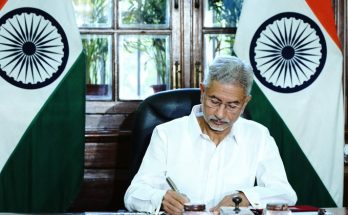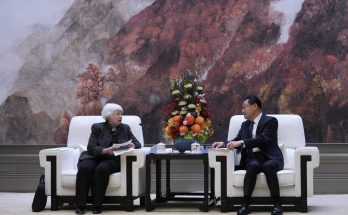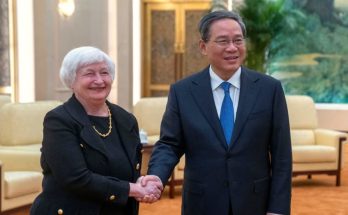 Rhetoric sometimes swings wildly, especially when it comes to prickly relations between the two continent-sized neighbours. Only a few days ago, the media headlines were seething with grim scenarios of rivalry and confrontation between the “two Asian giants” in the wake of the April 15 incursion of Chinese troops into eastern Ladakh. The spectre of the ‘China threat’ was haunting sections of India’s diplomatic-strategic establishment. Or, at least, that’s how it was made out to be. The mood swing is now perceptible, with sweet talk seamlessly replacing gloom-and-doom scare-mongering.
Rhetoric sometimes swings wildly, especially when it comes to prickly relations between the two continent-sized neighbours. Only a few days ago, the media headlines were seething with grim scenarios of rivalry and confrontation between the “two Asian giants” in the wake of the April 15 incursion of Chinese troops into eastern Ladakh. The spectre of the ‘China threat’ was haunting sections of India’s diplomatic-strategic establishment. Or, at least, that’s how it was made out to be. The mood swing is now perceptible, with sweet talk seamlessly replacing gloom-and-doom scare-mongering.
Springtime Thoughts
Fresh from his first trip to Beijing, India’s External Affairs Minister Salman Khurshid has conjured up the prospects of a new spring in India-China ties, saying that both sides are diligently preparing a substantive joint declaration during Chinese Premier Li Keqiang’s first visit to New Delhi later this month. The two countries are looking at a joint declaration that should send “a strong message to our people, to Asia and the world,” he told reporters in New Delhi May 11. The subtext is perhaps aimed at the West: Don’t portray us as rivals and enemies, we are friends and partners.

In his talks with his Chinese counterpart Wang Yi and Chinese Premier Li, Khurshid said he got the impression that China has taken “a conscious and deliberate decision” to make New Delhi the first stop of the maiden overseas visit by the premier May 19. This has been done to signal that developing relations with India is a high priority for China’s new leadership, he said.
In an hour-long interaction, Khurshid, an Oxford-educated lawyer and politician, turned on the full flow of his eloquence to convince a sceptical media that despite the unresolved mystery of the incursion incident and an un-demarcated border which lies at the heart of tensions between the two Asian powers, India and China were moving up the ladder in their relationship. Mixing diplomacy with his quasi-poetical impressions of springtime blossoms in Tiananmen Square, Khurshid said that he was charmed by the warmth and friendliness of ordinary Chinese people on the streets of Beijing, not to speak of their leaders.
Indeed, it’s interesting times for India and China and India-China relations. This will be the first time the leaders of India and China will visit each other’s country in the same year since 1954. Manmohan Singh is expected to visit Beijing later this year. If all goes according to plan, he could go there as early as June-end.
Premier Li’s New Delhi Visit
Coming down to specifics, Chinese Premier Li’s maiden trip to New Delhi and Mumbai promises to iron out some creases in a multi-faceted relationship that continues to be marred by trust deficit and, hopefully, will infuse a fresh burst of energy into this vital relationship between the two emerging powers. Refreshingly, both sides are seemingly moving beyond posturing and talking the language of pragmatism. Khurshid provided a sneak preview of the pacts that are expected to be signed during the visit. More important, they will focus on areas that will touch the lives of people and the economic fortunes of the two countries in times of the global slowdown. The foreign minister said that both sides were ready to sign some economic-related pacts in areas of micro-irrigation and waste management that flowed from the two rounds of strategic economic dialogue they have held so far. A pact on liberalising the visa regime that will ease travel for tourists and businessmen is being actively discussed between the two sides. Other pacts that are expected to be signed include an MoU on linking sister cities and the Chinese assistance to set up a mega industrial park for Chinese firms in India.
On the issue of economic relations that have remained a sturdy pillar of bilateral ties, a new strategy appears to be shaping up to scale up two-way investment flows to address the problem of trade deficit. India-China bilateral trade has exceeded $70 billion, but the trade imbalance of around $39 billion favouring China is becoming increasingly unviable. India is hoping that China will finally open the doors of its lucrative market for Indian IT and pharmaceutical companies.
Two-Track Theory
Another important takeaway from the foreign minister’s visit was the endorsement of what the foreign minister called “the two-track approach” in nurturing this critical relationship. Simply put, it means the two countries should continue expanding their economic relations and collaboration in international fora on one track, while continuing to resolve the more complex issues like the boundary dispute on another track. The hope is that “the gravitational pull of the success” on one track will influence the aspirations on the other, or cushion differences on another track. In contemporary context, it would mean that incursion incidents could happen again, but this should not be allowed to adversely affect the big-picture India-China relationship. Said Khurshid: “We both believe that our vision and our commitment is to the larger picture between China and India and we both are equally determined that such incidents should not be allowed to stand in the way and to obstruct very meaningful growth in our relationship.”
Managing Incursions
Rebutting reports that he did not discuss the incursion incident in Beijing, Khurshid clarified that he took up the issue with the Chinese premier. “I did say to the Chinese side and shared with premier that we felt it is important to analyse our respective systems and to work out why such things happened and we would be able to take some lessons from the manner in which it was resolved to ensure such things do not get repeated,” he said. “And, if at all, despite best efforts such things happen, then we are able to address it with great urgency and less passage of time then we had suffered this time which was three weeks.” On May 5, a 20-day India-China stand-off ended, with troops of both sides pulling back to their respective positions prior to April 15, when Chinese troops intruded 19 km deep inside the Depsang Bulge in eastern Ladakh. To maintain peace and tranquillity along the Line of Actual Control, India has given its own suggestions in response to a Chinese proposal for a Border Defence Cooperation Agreement that seeks to intensify lines of communication between border troops of the two countries.
India, China Partners, Not Rivals
Against this backdrop of mutual flexibility and the spirit of accommodation, the stage looks set for a feel-good summit meeting between Indian Prime Minister Manmohan Singh and his Chinese guest in the Indian capital May 20. The emphasis will be on transmitting the message to the world that India and China are mature enough to manage occasional frictions in their relations, but are not rivals, as portrayed in influential opinion-making establishment in the West. But it will not be just diplomatic theatrics. If the two sides can unveil doable tangible initiatives to reduce the trade imbalance, intensify strategic communication to discuss prickly issues upfront and reaffirm the political will not to let the border issue affect the larger relationship, the May 20 Manmohan Singh-Li Keqiang meeting could be construed as reasonably successful.
Above all, the leaders of India and China have to move beyond competitive geo-politics and temptations of one-upmanship. They need to make diplomacy more people-centric. The people of India and China – home to impoverished majorities itching for a better life — deserve a better deal from their leaders. Are the spring blossoms in Beijing, which the suave foreign minister waxed lyrical about, an invitation to the two Asian powers to help flower and fructify the potential of their two-and-a-half billion people? This is an overwhelming question, and one which time alone can answer. In the ‘Year of the Water Snake,’ anything can happen. As W.H. Auden wrote: “Perhaps the roses really want to grow,/ The vision seriously intends to stay;/ If I could tell you I would let you know.”
Author Profile

- Manish Chand is Founder-CEO and Editor-in-Chief of India Writes Network (www.indiawrites.org) and India and World, a pioneering magazine focused on international affairs. He is CEO/Director of TGII Media Private Limited, an India-based media, publishing, research and consultancy company.
Latest entries
 India and the WorldJuly 9, 2024Defying West, India sets $100 billion trade target with Russia
India and the WorldJuly 9, 2024Defying West, India sets $100 billion trade target with Russia India and the WorldJuly 5, 2024India at SCO: Takes swipe at Pakistan for cross-border terror, pushes alternative to BRI
India and the WorldJuly 5, 2024India at SCO: Takes swipe at Pakistan for cross-border terror, pushes alternative to BRI India and the WorldJune 14, 2024Modi’s Day 1 in Italy: Bonding with Britain, France
India and the WorldJune 14, 2024Modi’s Day 1 in Italy: Bonding with Britain, France India and the WorldJune 13, 2024G7 summit in Italy: Modi to showcase India as leader of Global South
India and the WorldJune 13, 2024G7 summit in Italy: Modi to showcase India as leader of Global South






